Ulster Football Final Statistical Analysis
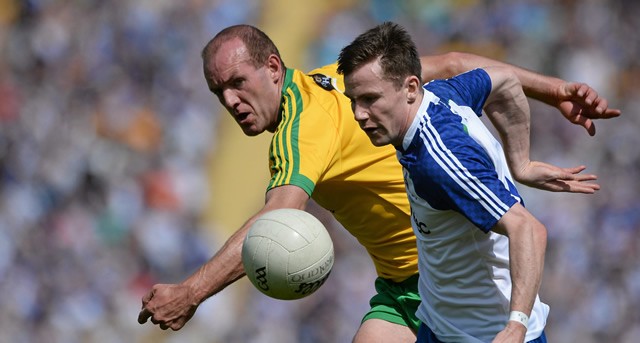
In the build up to the Ulster Football Final, Ulster GAA carried out a preview based upon the statistics both teams had delivered in previous 2015 Ulster Championship encounters.
Some of the key predictions were:
1) Donegal would win the kick out battle and as a consequence, overall possession share;
2) Monaghan would be more productive with their possession;
3) The ultimate outcome would be a draw, with the possibility of a marginal Monaghan victory owing largely to their better productivity with possession.
So, how did the game develop, and how accurate were the predictions?
Kick Out Statistics
Donegal emerged with 60% of the kick out possession to Monaghan’s 40%. Marginal superiority in the first half, was built upon in the second half to ensure Donegal established a strong foothold from the perspective of possession. Donegal’s success from kick outs was due mainly to their use of short kick outs, having taken 12 of their 19 kicks short (63%). Overall, Donegal secured possession from 16 of their 19 kick outs, a success rate of 84%.
Monaghan were prevented from using the short kick out on a number of occasions through Donegal’s tactic of pushing up for Monaghan kick outs. This reduced Monaghan to taking 6 kick outs short (25%). The remaining 18 kicks (75%) were played to contested areas, of which Monaghan could only secure 8, losing 10 – a success rate of 44% from their own kick outs into contested areas. Once again, Monaghan struggled with their own kick outs when forced to play them to these contested areas.
Figure 1: Kick Outs Won
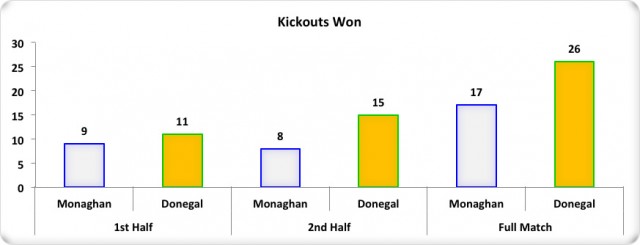
Figure 2: Kick Out Breakdown
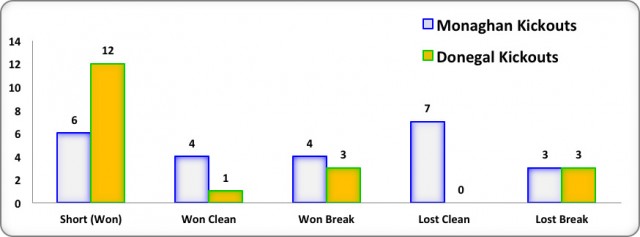
Turnovers
Both teams were protective of possession, with Donegal losing out 22 times, while Monaghan were superior, only losing possession 20 times. In any game, one form of turnover will cause concern for each team. Monaghan will note 9 possessions lost in the tackle, while Donegal will focus on 4 possessions surrendered through concession of a free. While neither is particularly high, margins at this level are miniscule and lowering the chances of turning possession over is paramount in any team’s preparations.
Notably, the first stray kick pass in this game came in the 27 minute, with a Donegal long ball to the square which was dealt with by the Monaghan defence. Monaghan’s only unsuccessful kick pass did not arrive until the 67th minute. Both these statistics highlight the emphasis placed on possession retention, and subsequent avoidance of riskier kick passing in favour of the safer but potentially less incisive hand passing.
Figure 3: Turnovers
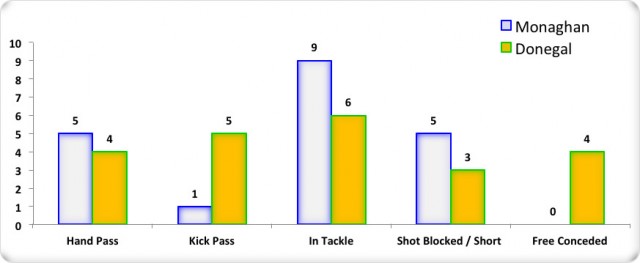
Possession to Scores Ratios
As forecast, Donegal’s superiority in the kick out stakes enabled them to secure 47 possessions (53%), to Monaghan’s 41 (47%). Both were able to convert a high majority of possessions to attacks – Monaghan progressing 87% into the attacking zone, while Donegal managed to get 89% inside the 45m. This statistic highlights the defensive strategy employed by both teams – allowing their opponent possession, and not applying pressure until they have the ball inside the ‘danger zone’. This approach allows teams to get numbers (usually 14 players) back and organised quickly, before applying pressure inside their own 45m line.
The other side of the coin was evident immediately prior to half time – the only occasion in the first half that Monaghan tackled and pressurised a Donegal player in their own defensive zone. Early pressure applied to Christy Toye by Ryan Wylie resulted in Monaghan benefiting from a turnover and the immediate result was a successful point attempt by Conor McManus. Early pressure in an opponent’s defensive zone can reap much more frequent and speedy reward than waiting for them to progress possession up the pitch.
Monaghan converted 27% of their possessions to scores, while Donegal only managed 21%, despite having greater possession share and ultimately having more shots (28 versus Monaghan’s 26). Donegal’s early rounds (v Tyrone & Armagh) shooting form demonstrated a conversion rate of 50-60%, while in this game they could only convert 36%. It was evident as the game progressed that Donegal had kicked a lot of efforts wide, and the statistical analysis highlights just how costly these were, having totalled 14 in the match.
Figure 4A & 4B: Possession to Scores Ratios & Shot Outcomes
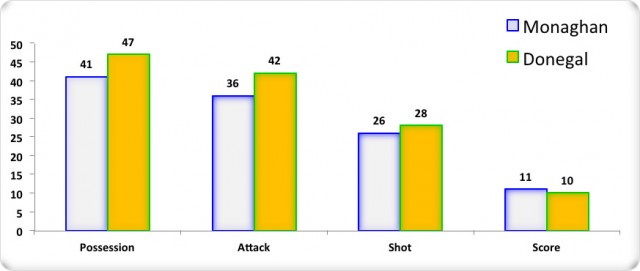
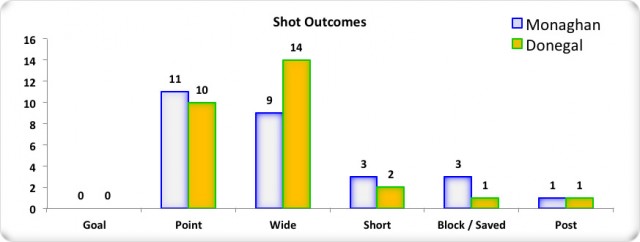
Once again, as predicted through analysis of each team’s previous performances Monaghan were the more productive team, returning 2.7 points per 10 possessions, in contrast to Donegal’s 2.1 points per 10 possessions. It is a testament to the execution of both team’s defensive strategies that both were limited to such low figures. However, Monaghan’s 0.6 advantage was enough to overall their deficiency in possession and deliver them to their one point victory.
Figure 5: Productivity
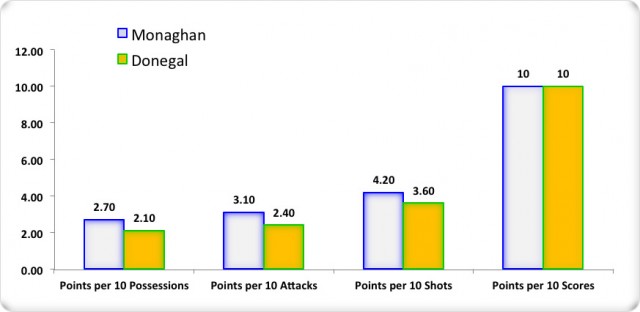
Summary
Both teams continued to display the weaknesses they had shown previously in this year’s Ulster championship, in particular during their semi-final victories. Donegal struggled in front of goal, and only converted 36% of their shots to scores – a figure which in the past can be closely linked to defeat for Donegal. Monaghan struggled with their own kick outs, in particular when Donegal pushed up and pressurised them into taking longer kicks.
Despite their advantage in possession, Donegal’s inability to convert chances cost them the result, while Monaghan were able to be productive enough with limited possession in order to shade the victory.
Donegal
Donegal lost this match by the minimum margin, despite the fact that they enjoyed the majority of possession, and only converted 36% of their shots to scores. There is no question that Donegal can still have a big impact in this year’s All Ireland series. Their shooting against Armagh and Tyrone averaged 55% success – had they replicated that in the Ulster final they would have scored at least 14 points – and may well have emerged with the victory. Improvement in this area will certainly be high on the priority list ahead of their meeting with Galway.
Monaghan
Monaghan managed to get the result, which in the Ulster final is all important. However, they will have targeted further progression in the All-Ireland series than they have managed in the previous few years so they will still be keen to improve where possible. In each of their games so far in the championship Monaghan have failed to win the kick out battle. This is placing a heavy reliance on their ability to force turnovers, but also on their ability to convert possessions to scores. Of particular concern will be their struggle to win their own kick outs when they are unable to use the short kick option. If they can increase their success in this aspect of their game they should gain a better share of possession in subsequent games. If they then maintain their productivity they could increase their scoring capacity by 2-3 scores per game, while also lowering the opportunities their opponents have to score.






